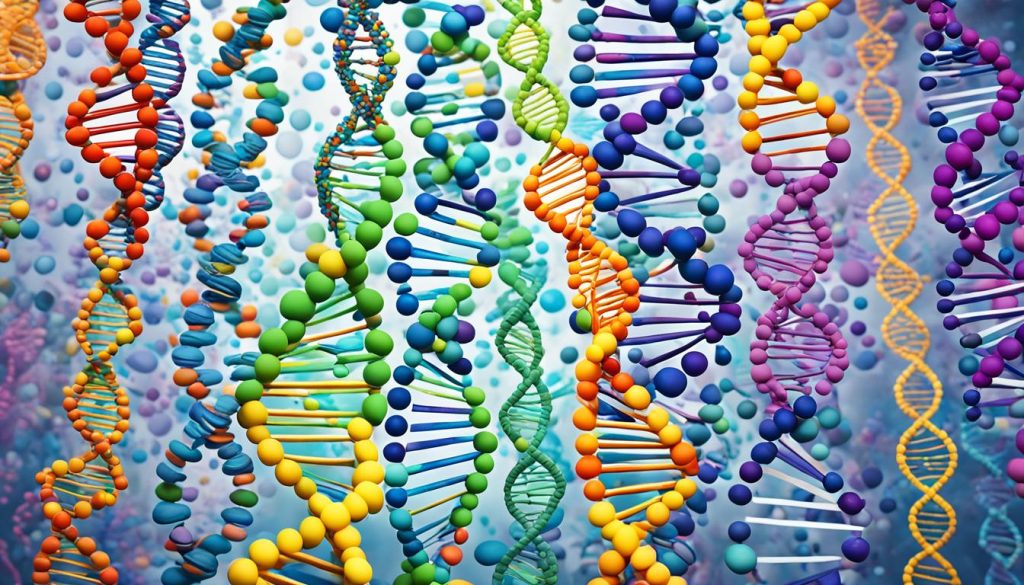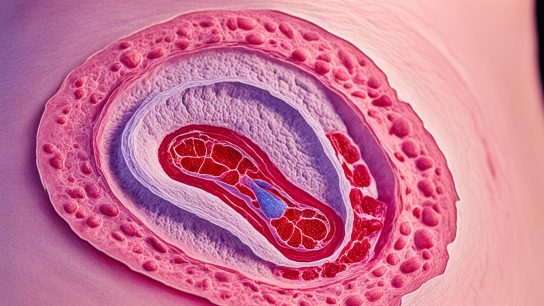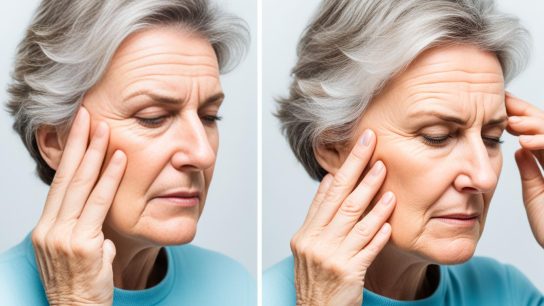Ehlers-Danlos syndrome (EDS) is a rare hereditary disorder that affects the body’s connective tissues, including the skin, joints, and blood vessels. The most common type of EDS is hypermobile EDS (hEDS), which is characterized by joint hypermobility, easy skin bruising, digestive problems, dizziness, and urinary incontinence. In this article, we will explore 23 signs that indicate a person grew up with Ehlers-Danlos Syndrome based on shared experiences.
What is Ehlers-Danlos Syndrome?
Ehlers-Danlos syndrome (EDS) is a genetic condition that affects the body’s connective tissues, which provide support and structure to the skin, joints, and organs. Connective tissues are made up of proteins like collagen and elastin, and they play a crucial role in the strength and elasticity of various body parts.
There are 13 subtypes of EDS, each with its own set of symptoms and severity. The most common type is hypermobile EDS, which accounts for about 80% of all EDS cases. Hypermobile EDS is characterized by joint hypermobility, where the joints have an unusually large range of motion. Individuals with hypermobile EDS may experience joint pain, dislocations, and subluxations, along with fragile and stretchy skin that is prone to bruising and scarring. Chronic pain is also a common symptom associated with this subtype.
Other subtypes of EDS include:
- Classical EDS: Characterized by stretchy and fragile skin, joint hypermobility, and a tendency to develop scars and wounds that heal poorly. This subtype is caused by abnormalities in collagen type 5.
- Vascular EDS: Considered the most severe subtype due to the risk of arterial and organ rupture. It is characterized by thin and translucent skin, easily visible veins, fragile blood vessels, and characteristic facial features.
- Kyphoscoliotic EDS: Known for severe curvature of the spine (scoliosis) and muscle weakness. Joint hypermobility and fragile skin may also be present.
These are just a few examples of the different types of EDS. Each subtype has its own distinct set of symptoms and complications, which can range from mild to severe. Genetic testing is often necessary to confirm the subtype of EDS and guide treatment options.
Here is an image visualizing the different types of Ehlers-Danlos Syndrome:
As you can see, the different subtypes of Ehlers-Danlos Syndrome have unique characteristics and affect various parts of the body. Understanding the specific subtype is crucial for proper diagnosis, management, and support.
Is Ehlers-Danlos Syndrome Genetic?
Yes, Ehlers-Danlos syndrome (EDS) is a genetic disorder that is passed down through families. Over 20 genes have been found to be associated with EDS, including COL1A1, COL1A2, COL3A1, and COL5A2.
These genes play a crucial role in the production of collagen, which is a protein that provides strength and structure to the body’s connective tissues, such as the skin, joints, and organs. Changes or mutations in these genes can lead to abnormalities in collagen production, resulting in weak or stretchy connective tissues.
Each subtype of EDS is caused by variants in different collagen genes. For example, the classical subtype is primarily caused by mutations in the COL5A1 or COL5A2 genes, while the vascular subtype is caused by mutations in the COL3A1 gene.
Understanding the genetic basis of Ehlers-Danlos syndrome is crucial for accurate diagnosis and management of the condition. Genetic testing may be used to confirm a diagnosis of EDS and determine the specific subtype. This information can guide treatment decisions and help individuals manage their symptoms effectively.

Genetic counseling is also an essential component of EDS care, as it provides individuals and families with information about the inheritance patterns of the condition and the potential risks for future generations. By understanding the genetic basis of Ehlers-Danlos syndrome, healthcare professionals can offer targeted support and interventions to improve the quality of life for individuals with EDS and their families.
How is it Diagnosed?
Diagnosing Ehlers-Danlos Syndrome (EDS) can be challenging as there are no specific diagnostic tests available. Instead, healthcare professionals rely on a combination of the individual’s medical history, reported symptoms, and a thorough physical examination.
During the physical examination, the doctor will assess factors such as joint hypermobility, skin elasticity, and any signs of tissue fragility. They may also inquire about symptoms such as chronic pain, joint dislocations, and gastrointestinal issues.
In some cases, a genetic test may be recommended to confirm the diagnosis and identify the specific subtype of EDS. This test analyzes the individual’s DNA for variations in genes associated with EDS, helping to provide a more precise diagnosis.
Unfortunately, the process of diagnosing EDS can take years or even decades. The nonspecific nature of the symptoms and the rarity of the condition often result in misdiagnoses or the dismissal of symptoms as simply growing pains. It is essential for individuals experiencing symptoms of EDS to persist in seeking medical attention and advocate for a thorough evaluation.
Diagnostic Process for EDS:
- Medical history review
- Physical examination to assess joint hypermobility, skin elasticity, and tissue fragility
- Discussion of reported symptoms, such as chronic pain, joint dislocations, and gastrointestinal issues
- Genetic testing to confirm diagnosis and determine the specific subtype of EDS

Early and accurate diagnosis of EDS is crucial as it allows for appropriate management and treatment strategies to be implemented. If you suspect you or a loved one may have EDS, it is important to consult with a healthcare professional who is knowledgeable about the condition.
Common Symptoms of Ehlers-Danlos Syndrome
Ehlers-Danlos syndrome (EDS) is a complex condition that can manifest in a variety of symptoms. These symptoms can vary in severity depending on the specific subtype of EDS. Here are some common symptoms that individuals with Ehlers-Danlos syndrome may experience:
- Joint hypermobility
- Joint instability
- Stretchy skin
- Delayed milestones
- Chronic pain
- Fatigue
- Difficulty with fine motor skills
- Poor balance
- Dental issues
- Frequent dislocations
- Joint pain
- Poor wound healing
- Digestive issues
- Heart disease
- Sensory processing issues
These symptoms can have a significant impact on the daily lives of individuals with Ehlers-Danlos syndrome. It is important to note that not everyone with EDS will experience all of these symptoms, and the severity of symptoms can vary from person to person.

Joint Hypermobility and Joint Instability
One of the hallmark symptoms of Ehlers-Danlos syndrome is joint hypermobility. This means that the joints have a greater range of motion than normal, which can lead to joint instability and an increased risk of dislocations. The skin may also be stretchy and more fragile than usual.
1. Chronic Pain and Fatigue
Chronic pain is a common symptom of Ehlers-Danlos syndrome. This pain can be widespread and affect multiple areas of the body. Fatigue is also frequently reported by individuals with EDS, likely due to the strain on the body caused by joint instability and chronic pain.
2. Other Symptoms
In addition to the symptoms mentioned above, individuals with Ehlers-Danlos syndrome may also experience difficulty with fine motor skills, poor balance, dental issues, poor wound healing, digestive problems, heart problems, and sensory processing issues. These symptoms can significantly impact daily life and overall well-being.
23 Signs You Grew Up With Ehlers-Danlos Syndrome

Growing up with Ehlers-Danlos Syndrome (EDS) presents unique challenges and experiences. If you’re wondering whether your childhood was impacted by EDS, here are 23 signs that indicate you may have grown up with this condition:
- High flexibility of joints
- Clumsiness
- Frequent tripping or falling
- Frequent joint dislocations, especially of the knee or elbow
- Ability to bend fingers or thumb backward
- Increased frequency of fracturing bones
- Hyperextended knees
- Feeling you are double-jointed
- Fear of relaxing your joints for fear of dislocation
- Frequent dizzy or fainting spells
- Fewer wrinkles
- Frequent foot problems, especially pain and discomfort
- Digestive issues like bloating, diarrhea, nausea, acid reflux
- Extreme fatigue
- Holding a pen or pencil differently to avoid pain or dislocation
- Taking longer to complete everyday activities
- Increased likelihood of migraines, vision issues, or POTS
- Chronic body pain at a young age
- Running with a different gait than others
- Picky about clothing to protect sensitive skin
- Joints make clicking or popping noises
- Growing pain in the ankles
- Inability to run fast
These signs can vary in severity and may manifest at different stages of life for individuals with EDS. If you identify with several of these signs, it is advisable to consult with a medical professional for an accurate diagnosis and appropriate management of your symptoms.
| Signs | Description |
|---|---|
| High flexibility of joints | Joints exhibit a greater range of motion than typical |
| Clumsiness | Often tripping, stumbling, or dropping objects |
| Frequent joint dislocations | Joints regularly pop out of place, especially knees or elbows |
| Ability to bend fingers or thumb backward | Fingers or thumbs can be flexed in an abnormal direction |
| Increased frequency of fracturing bones | Bones are more prone to fractures even with minor impact |
| Hyperextended knees | Knees bend backward beyond the usual range |
| Feeling you are double-jointed | Believing you have an unusual level of joint flexibility |
| Fear of relaxing joints | Feeling anxious about joints popping out if not careful |
| Frequent dizzy spells | Experiencing frequent episodes of dizziness or lightheadedness |
| Fewer wrinkles | Noticing fewer wrinkles than peers of similar age |
| Frequent foot problems | Experiencing pain and discomfort in the feet regularly |
| Digestive issues | Experiencing problems like bloating, diarrhea, nausea, acid reflux |
| Extreme fatigue | Feeling persistently exhausted, despite adequate rest |
| Different pen/pencil grip | Adopting a unique grip to avoid joint pain or dislocation |
| Difficulty completing tasks | Taking more time to finish everyday activities due to pain or limitations |
| Increased likelihood of migraines | Migraines occur more frequently than in the general population |
| Chronic body pain | Experiencing persistent pain in multiple areas of the body at a young age |
| Different running gait | Running with a distinctive style to compensate for joint instability |
| Sensitive skin and clothing | Being selective about clothing to avoid discomfort and skin irritation |
| Clicking or popping joints | Joints produce audible noises when moved |
| Growing pain in the ankles | Experiencing pain during growth spurts specifically in the ankles |
| Inability to run fast | Not being able to achieve high running speeds compared to peers |
How Does Ehlers-Danlos Syndrome Affect Daily Life?
Ehlers-Danlos syndrome (EDS) can have a significant impact on daily life, presenting everyday challenges for individuals living with the condition. The symptoms of EDS, such as chronic pain, fatigue, joint instability, and frequent dislocations, can make it difficult to engage in physical activities and affect overall mobility.
One of the challenges faced by individuals with EDS is sensitivity to touch, sound, and light. Everyday experiences that may seem mundane or simple for others can become more challenging and overwhelming due to these sensitivities.
Managing daily life with EDS often requires adaptive aids or modifications to the environment to minimize pain and reduce the risk of injury. These may include using assistive devices like braces or splints to support unstable joints, making adjustments to home or work spaces to accommodate mobility limitations, and implementing strategies to navigate the physical and sensory challenges posed by EDS.
Living with EDS means adapting to a new normal and finding ways to maintain a fulfilling life despite the limitations imposed by the condition. It may involve redefining priorities, seeking support from healthcare professionals, and connecting with others who share similar experiences through support groups or online communities.
Managing Daily Life with Ehlers-Danlos Syndrome
To navigate the everyday challenges of living with Ehlers-Danlos syndrome, some tips and strategies may be helpful:
- Develop a support network: Surround yourself with understanding and supportive individuals, including family, friends, and healthcare professionals.
- Practice self-care: Implement activities that promote physical and mental well-being, such as gentle exercises, meditation, and relaxation techniques.
- Seek professional guidance: Work with healthcare professionals specializing in EDS management, such as physical therapists, occupational therapists, and pain management specialists.
- Adapt daily activities: Make modifications to tasks and routines to minimize the risk of dislocations or injuries.
- Use assistive devices: Explore the use of adaptive aids, such as mobility aids or ergonomic tools, to support joint stability and reduce strain.
- Manage fatigue: Schedule regular rest breaks and establish healthy sleep patterns to manage fatigue associated with EDS.
- Educate yourself: Stay informed about the latest research and developments related to EDS to empower yourself in managing the condition effectively.
By incorporating these tips into daily life, individuals with Ehlers-Danlos syndrome can work towards maintaining a sense of control, minimizing symptoms, and enjoying a higher quality of life despite the challenges posed by the condition.
Tips for Managing Ehlers-Danlos Syndrome
Managing Ehlers-Danlos syndrome requires a comprehensive approach to address the various symptoms and challenges associated with the condition. Here are some helpful tips for effectively managing Ehlers-Danlos syndrome:
- Taking pain-relieving medications as prescribed: Consult with your healthcare provider to develop an appropriate pain management plan that may include medications to alleviate discomfort.
- Engaging in physical therapy: Regular physical therapy sessions can help strengthen muscles, improve joint stability, and enhance overall mobility.
- Using braces or splints: Supportive braces or splints can provide stability and protection to unstable joints, reducing the risk of dislocations and injuries.
- Practicing good self-care: Prioritize self-care activities such as adequate rest, balanced nutrition, and maintaining a healthy lifestyle to support overall well-being.
- Seeking emotional support: Consider seeking emotional support through counseling or connecting with support groups to cope with the emotional challenges associated with Ehlers-Danlos syndrome.
- Developing adaptive strategies: Find ways to adapt daily activities to minimize the risk of dislocations or injuries. Work with occupational therapists or specialists to explore assistive devices or modifications that can improve your quality of life.
- Regularly consulting with healthcare professionals: Stay in regular contact with your healthcare team to monitor symptoms, discuss progress, and make adjustments to your treatment plan as needed.
By implementing these tips and working closely with healthcare professionals, individuals with Ehlers-Danlos syndrome can better manage their condition and enhance their overall well-being.
Treatment for Ehlers-Danlos Syndrome
While there is no cure for Ehlers-Danlos syndrome, various treatment approaches can help manage symptoms and prevent further complications. Treatment plans are often tailored to the individual’s specific subtype of EDS and their unique needs.
1. Pain Management
Pain management is a crucial aspect of EDS treatment. Medications such as nonsteroidal anti-inflammatory drugs (NSAIDs), acetaminophen, and opioid analgesics may be prescribed to alleviate pain and improve quality of life.
2. Physical Therapy
Physical therapy plays a vital role in strengthening muscles and stabilizing joints in individuals with EDS. Specific exercises and techniques are designed to improve joint stability, increase flexibility, and enhance overall functional abilities. Physical therapy can also help manage pain and prevent further joint damage.
3. Joint Support
The use of braces, splints, or orthotic devices can provide additional support to unstable joints and reduce the risk of dislocations. These assistive devices can help improve mobility, enhance joint stability, and minimize pain associated with movements.
4. Surgical Intervention
In severe cases of EDS, when joint dislocations or organ ruptures become recurrent and debilitating, surgical intervention may be necessary. Surgeries can address structural abnormalities, repair damaged tissues, and improve overall joint function.
5. Genetic Counseling
Genetic counseling can be beneficial for individuals with EDS and their families. It helps to understand the inheritance pattern, potential risks for future generations, and provides information about family planning options and prenatal testing.
| Treatment Options | Benefits |
|---|---|
| Pain Management | Provides relief and improves quality of life |
| Physical Therapy | Strengthens muscles, stabilizes joints, and manages pain |
| Joint Support | Enhances joint stability and reduces the risk of dislocations |
| Surgical Intervention | Addresses severe complications and improves joint function |
| Genetic Counseling | Provides understanding of inheritance patterns and family planning options |
Working closely with healthcare professionals, individuals with Ehlers-Danlos syndrome can develop personalized treatment plans that align with their specific needs and goals. It is important to consult with qualified medical experts to determine the best treatment options and ensure comprehensive care.
Resources and Support for Those with Ehlers-Danlos Syndrome
Living with Ehlers-Danlos syndrome (EDS) can be challenging, but there are numerous resources and support systems available to help individuals navigate the condition. Support groups and online communities offer valuable opportunities for individuals with EDS to connect with others who share similar experiences. These platforms provide a safe space to seek advice, share stories, and find comfort in knowing that they are not alone in their journey.
Alongside community support, medical professionals specializing in EDS, such as occupational therapists, physiotherapists, and genetic counselors, play a crucial role in providing guidance and support for managing the condition. They can offer specific insights into effective strategies for improving daily life, managing pain, and maintaining overall well-being.
When seeking information and assistance, it is essential to rely on trusted sources and reputable organizations dedicated to understanding Ehlers-Danlos syndrome. These resources can provide reliable and up-to-date information on various aspects of the condition, including medical advancements, treatment options, and coping mechanisms. Additionally, individuals with EDS should advocate for their own healthcare needs and actively participate in discussions and decision-making processes related to their well-being.
Conclusion
Ehlers-Danlos syndrome (EDS) is a complex genetic condition that affects connective tissues, resulting in various symptoms and challenges in daily life. Although living with EDS can present unique experiences and difficulties, individuals can lead fulfilling lives with proper management and support.
Early diagnosis and awareness of the signs and symptoms of EDS are crucial for timely intervention and appropriate management. While there is no cure for EDS, there are strategies available to help manage the symptoms and prevent complications.
Managing EDS requires a multidisciplinary approach to healthcare, involving healthcare professionals such as physicians, physical therapists, and counselors. Medication, physical therapy, and, in some cases, surgery, can be utilized to effectively manage symptoms and improve quality of life.
Genetic counseling also plays a significant role in living with EDS. It provides individuals with a better understanding of the condition, its inheritance patterns, and allows them to make informed decisions about their health and the health of future generations.
FAQ
1. What are the signs of growing up with Ehlers-Danlos Syndrome?
Some signs of growing up with Ehlers-Danlos Syndrome include high flexibility of joints, frequent joint dislocations, the ability to bend fingers or thumbs backward, easy bruising, chronic fatigue, and dizziness upon standing.
2. What are the common symptoms of Ehlers-Danlos Syndrome?
Common symptoms of Ehlers-Danlos Syndrome include joint hypermobility, stretchy and fragile skin, chronic pain, easy bruising, gastrointestinal issues, fatigue, and delayed wound healing.
3. What complications can arise from Ehlers-Danlos Syndrome?
Complications that can arise from Ehlers-Danlos Syndrome include organ prolapse, vision issues, migraines, and postural orthostatic tachycardia syndrome (POTS).
4. How is Ehlers-Danlos Syndrome managed?
Ehlers-Danlos Syndrome is managed by treating individual symptoms. This may include using pain-relieving medications, physical therapy to strengthen muscles and stabilize joints, and in some cases, surgery for joint dislocations.
5. Can Ehlers-Danlos Syndrome be cured?
There is currently no cure for Ehlers-Danlos Syndrome. However, various strategies can be employed to manage the condition and improve quality of life.




